Turtles are intelligent creatures that love exploring their surroundings, so it is very important that we provide them with the best housing and environment. People often associate turtle tanks with murky water and a single fake plant in the corner, but that’s truly a shame. A good turtle tank can be just as lively and colorful as any other aquarium, and it’s actually relatively simple to achieve, once you know what it takes.
So, why exactly should you keep plants in your turtle tanks? And which plants are good for turtles anyway? What needs to be considered and what should you look out for when adding plants to your turtle tank?
These are all questions we will answer in this article. So, let’s get started!
Best Plants For Turtle Tanks
Ready to learn about which plants are best for your turtle enclosure? Here are some great options you can use to create a healthy environment.
1. Java Fern (Microsorum pteropus)

One of the easiest types of plant to take care of, Java Fern is a great option for beginners. It thrives in low light and doesn’t require frequent fertilization since it can survive on little bits of waste that accumulate inside your tank over time. Just remember to attach it to a solid surface using a fishing line or other sturdy materials such as nylon, since Java Fern requires a bit of anchor in order to survive.
Keep in mind that some turtles love to munch on Java Fern, so you should keep your tank under close supervision. If you notice that one of your turtles is chewing on the plant, it may be time to either change its location or remove it completely from the tank.
2. Java Moss (Taxiphyllum barbieri)

Another low-maintenance plant, Java Moss is great for turtle tanks because turtles are less likely to ingest it. This makes it the perfect option for pet turtles that enjoy lounging on hard surfaces such as rocks and logs. You can also purchase these plants in the form of a Java Moss stone pad for maximum convenience.
Though these awesome plants may not require any special nutrients, they still need some light to grow. If you see your moss is turning brown or yellow, it may be time to up the wattage on your lighting fixture.
3. Water Wisteria (Hygrophila difformis)
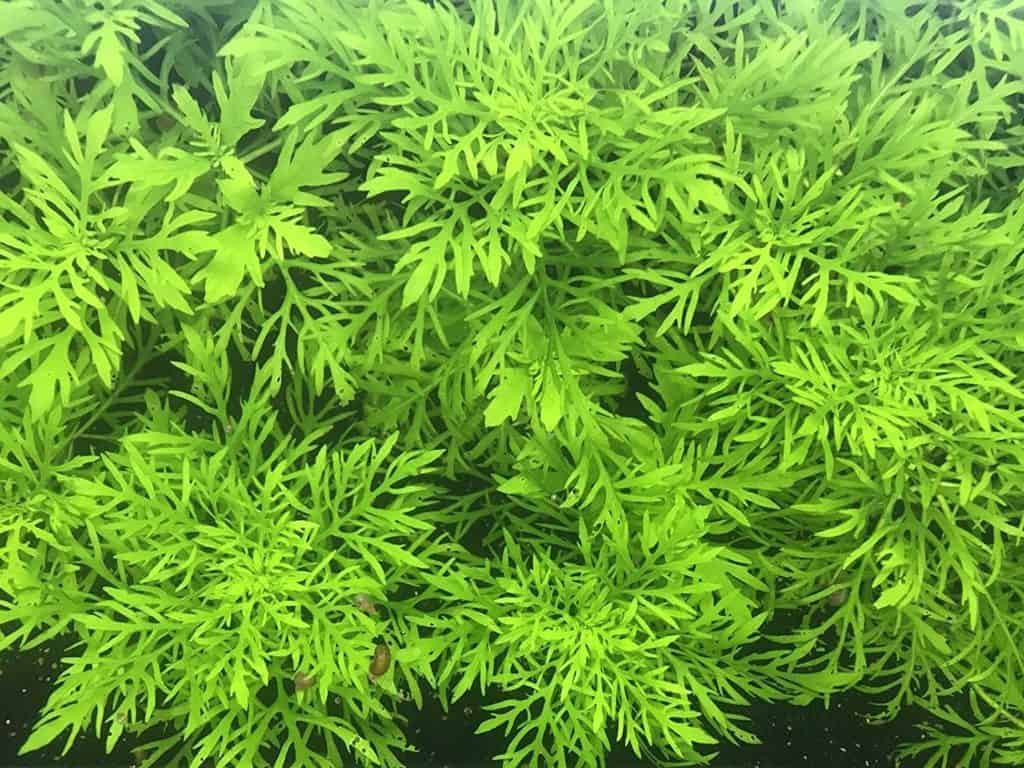
This beautiful plant is native to India and thrives in areas of low light or full sun depending on how much light it gets each day. Water Wisteria (Hygrophila difformis) also prefers gentle currents to hard streams, making it the perfect option for tanks with turtles that enjoy exploring.
Additionally, Water Wisteria is a great option for anyone looking to create a low-maintenance aquarium with a jungle theme. Plus, it can grow up to 27 inches long in the right conditions!
4. Anacharis (Elodea canadensis)

Though this plant may also be known as Egeria Densa, Anacharis is a great option for any turtle tank. It can grow up to six inches tall in most cases and thrives with just the right amount of light and nutrients. Plus, turtles are less likely to ingest this type of plant due to its waxy coating, so you don’t have to worry about them accidentally chomping down on it.
As a plus, Anacharis is a great option for any tank owner because it can adapt to a variety of conditions. In fact, this beautiful plant will even grow in low-oxygen water! Because of these awesome benefits, many turtle keepers consider Anacharis to be one of the best plants for turtle tank habitats.
5. Water Lettuce (Pistia stratiotes)
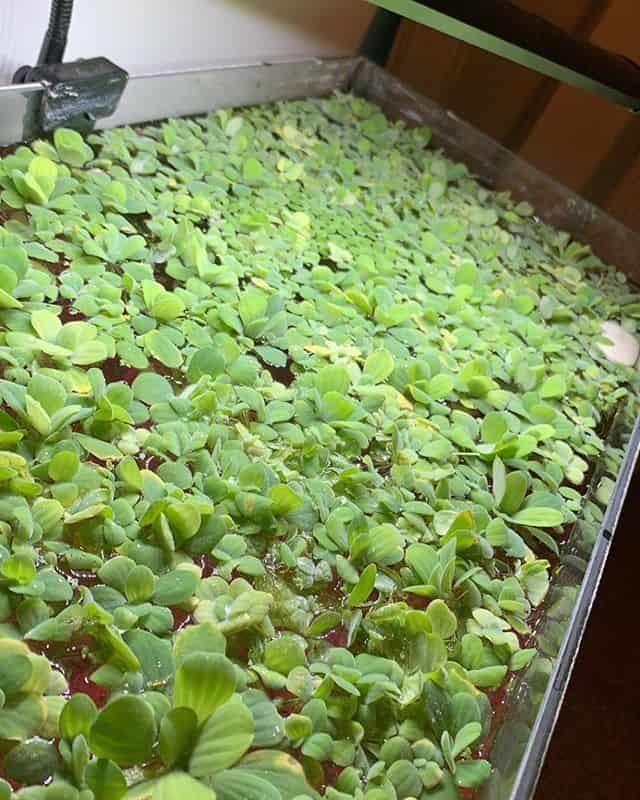
These delicate plants look like floating hearts and are perfect for any turtle tank that has plenty of room to grow. Just remember that this type of plant can’t adapt to changes in lighting conditions once it matures. Luckily, if the light levels in your tank change over time, these magnificent water lettuce plants will simply float off to find a new place to grow.
Water Lettuces can sometimes become a bit weedy, so if you notice the plant is multiplying too quickly in your tank it may be time to take some cuttings and share them with fellow turtle keepers.
6. Red Tiger Lotus (Nymphoides peltata)

This beautiful plant comes from China and is another one of the best plants for turtle tanks. Red Tiger Lotus thrives in water with low lighting, but also requires warmer temperatures than most types of aquatic plants.
Since these beauties thrive in low light, they’re perfect for any turtle tank that gets little light due to its setup or location. However, if you notice this plant appears to be withering, it may be time to up the wattage on your lighting fixture!
7. Anubias Coffeefolia
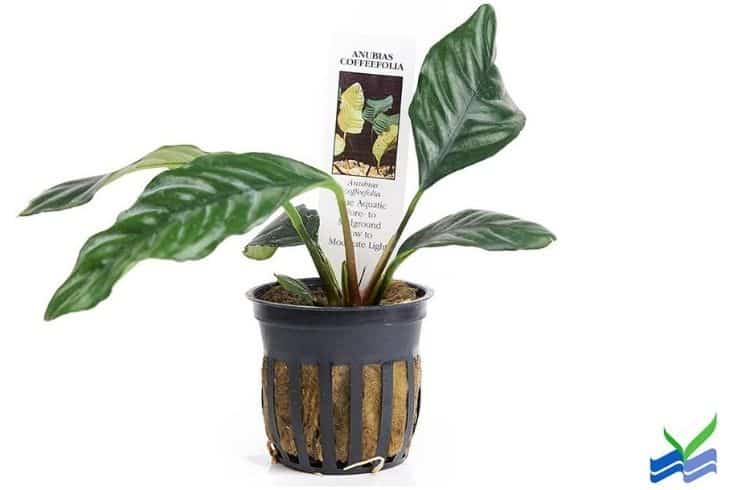
Anubia leaves are dark green, ovate, and quite tough. Because of their appearance, turtle tank owners usually use this type of plant to decorate the bottom of the tank. However, these aquatic beauties can also be attached to driftwood or rocks in order to create a truly stunning underwater landscape.
As long as your Anubias Coffeefolia gets enough light, it can adapt to just about any condition. Luckily, this beautiful plant is dioecious, meaning male and female plants are separate. This means you can choose which gender you’d like before purchasing the Anubias Coffeefolia for your turtle tank!
8. Bucephalandra (Bucephalandras)

This beautiful freshwater plant is native to the Cambodian jungle and has become increasingly popular with turtle tank owners because it thrives in low light. This attractive plant can adapt to a variety of growing conditions, making it perfect for your turtle enclosure if you’ve had issues maintaining other types of underwater foliage.
Keep in mind that Bucephalandra can grow up to twelve inches in length, so it’s best suited for tanks that are at least twenty gallons. Turtles are a bit less likely to eat this plant, but they may still try to snack on it from time to time. So if your turtles are daring enough to eat the leaves of these beautiful plants, you should either trim them or move Bucephalandra further away from their enclosure.
9. Sword Plants (Nomaphila stricta)

Sword Plants are a family of plants from the rainforest and have been used as decoration in aquariums for decades. In fact, it is such a favorite plant among turtle tank owners that it’s often referred to as a “Turtle Plant.”
Sword Plants require very little light to survive, and they will flower under low lighting conditions. They feed through their roots, so be sure to keep them in the top few inches of your tank’s substrate so they can absorb all the essential nutrients they need. Above all, they are beautiful, easy to maintain, and best of all – turtles won’t try to eat them!
10. Water Hyacinth (Eichhornia crassipes)
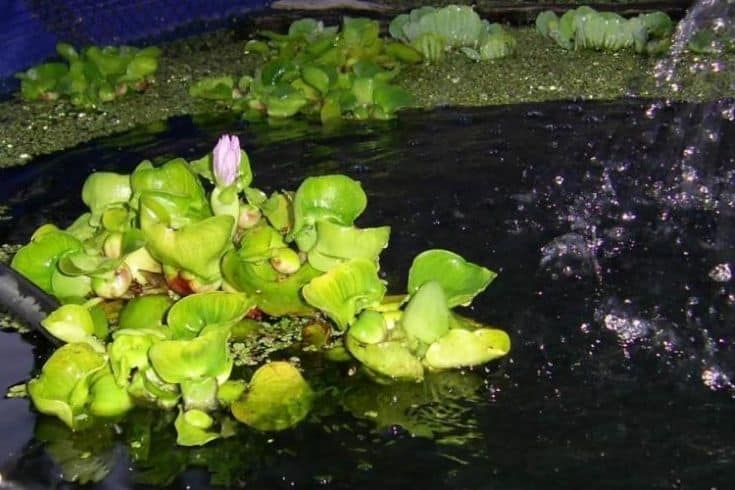
Surprising as it may seem, this unique aqua plant is often seen as an invasive species. As one of the fastest-growing plants on our list, the water hyacinth has been outlawed in several countries due to the damage it causes to local environments. This is unfortunate as the Water Hyacinth is one of the best plants for turtle tanks – but as long as you keep it away from waterways, you should be fine.
Water Hyacinths are so popular because they can adapt to almost any condition due to their unique root system. They feed via the water column, and they grow extremely quickly. The best part? Water Hyacinths are perfect for turtle tanks because their leaves are large, attractive, and turtles will not try to eat them. Perfect for any turtle tank!
11. Hornwort (Ceratophyllum demersus)
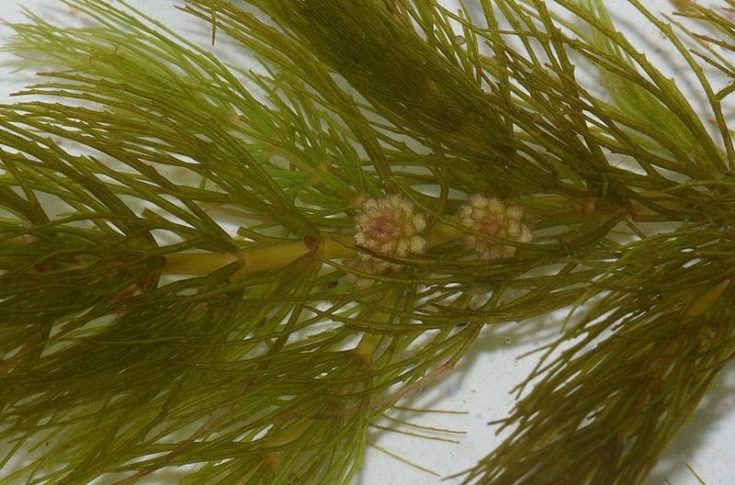
This aquatic plant is incredibly easy to maintain within the enclosure of any type of turtle. Hornwort thrives in low lighting, and can even grow in water that is brackish or saltwater. If your water conditions are less than ideal, this aquatic plant is the perfect choice for your turtle tank!
Hornwort is unusual in that it has very flexible, threadlike leaves. They are incredibly attractive and will grow to the surface of your water. Be sure to leave some leaf matter at the top of your tank so turtles can easily reach them without interfering with any equipment.
12. Anacharis (Egeria densa)

This entry-level plant is a staple in turtle tanks because it’s incredibly easy to care for. In fact, many people have been able to maintain an entire tank of turtles without ever having to worry about water conditions because Anacharis can adapt to just about any lighting and chemical environment.
Anacharis likes to root in the substrate, so be sure to keep the roots of this plant about two inches under your tank’s substrate. Although turtles are unlikely to eat Anacharis directly, it’s possible they’ll try to munch on the roots if they make them accessible. So give your Anacharis plenty of distance from any turtle tank equipment.
13. Cryptocoryne (Cryptocoryne spp.)
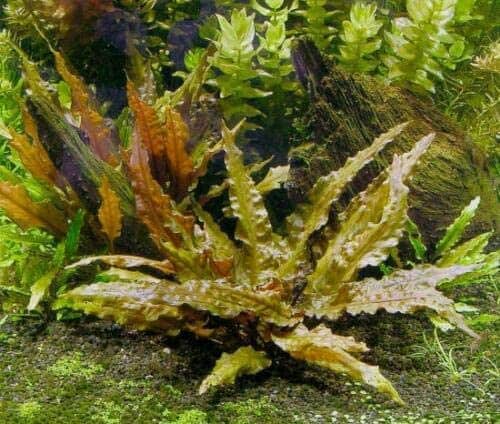
These awesome plants are incredibly popular with turtle owners due to their attractive, broad leaves. While there are several different types of Cryptocorynes – some even variegated – most only grow a few inches tall, which makes them perfect for a turtle tank.
Cryptocorynes are pretty low maintenance, and they don’t require a lot of light to grow and thrive. They also feed through their roots, so you can keep them anywhere within the substrate and they’ll be perfectly happy. However, for safety’s sake, it is best to keep Cryptocorynes away from any turtle tank equipment.
14. Vallisneria ( Vallisneria spp.)

Another incredibly popular aquatic plant, Vallisneria is also known as Eelgrass. It’s native to North America, Asia, and even some parts of Europe. Turtles love to swim through their beautiful foliage while they are at the top of your tank, but they are pretty low maintenance and turtles will not eat them.
Vallisneria thrives in almost any lighting conditions and appreciates carbon dioxide supplementation to help it grow faster. However, this isn’t a strict requirement because these awesome plants are able to grow at a decent rate under most circumstances.
15. African Water Ferns ( Microsorum pteropus)
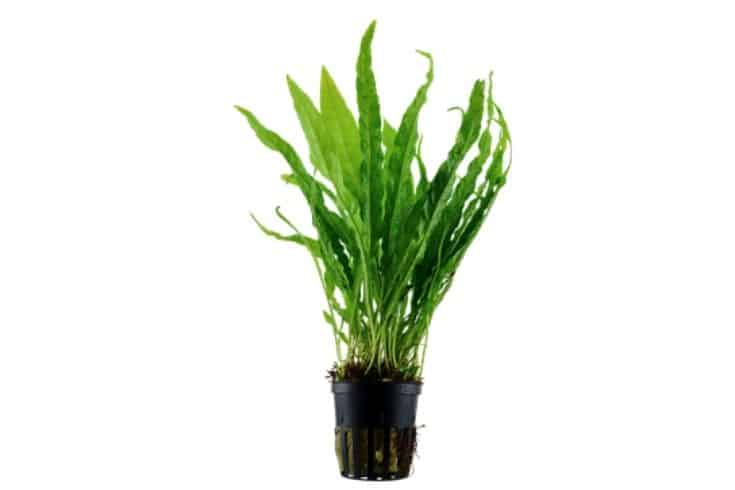
Native to West Africa, these ferns are incredibly popular with turtle owners because turtles will not eat them. African Water Ferns are also very, very low maintenance – they’re even known to grow in low lighting conditions!
Although African Water Ferns prefer to root in the substrate, they can survive just fine without being planted. Because their leaves are so long, these popular plants serve as the perfect hiding spot for any turtle within your tank.
Why Use Aquatic Plants In Turtle Tanks?
The reason we keep aquatic plants in turtle tanks is that they offer many benefits. Here are some good reasons to go with plants in your turtle enclosure:
Plants Act As Natural Filters
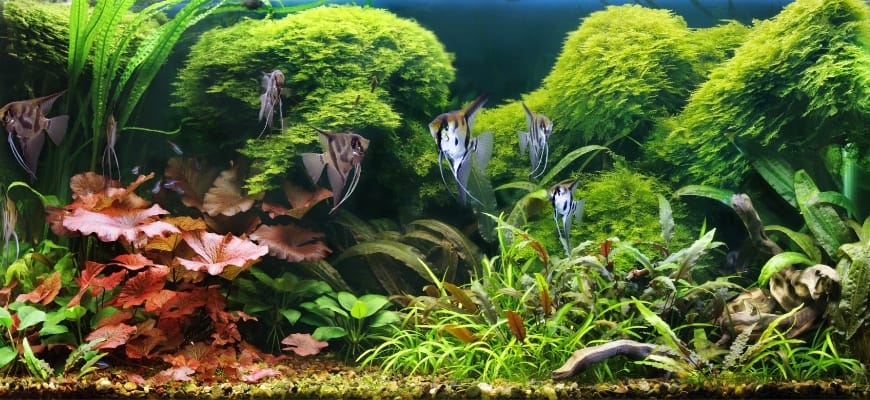
Did you know that aquatic plants serve an important function in aquatic habitats? They act as a natural water filter, absorbing excess nutrients and chemicals such as nitrates and phosphates from the water. That is why we often see dense aquatic plant growth in nature; they purify the water around them.
On top of that, your aquarium plant can also remove carbon dioxide and replace it with oxygen. This is great for your aquatic turtle because carbon dioxide can be harmful to them, and oxygen helps keep your turtle happy and active. In many ways, plants act as a backup water filtration system for your turtle enclosure, and if you use a variety of plants, your filtration capacity will be even better.
Plants Provide Cover For Adults And Hatchlings
Did you know that turtles, and indeed most reptiles and amphibians, require a hiding spot? Turtles like to feel safe and secure when they sleep, and a tough plant like an Amazon Sword can provide that cover. If your plant lacks strong roots, you can also anchor the plant onto aquarium gravel or a piece of driftwood. The end goal is to give your turtles a sense of security.
Another great thing about plants is that they provide additional cover for hatchlings. In other words, plants can help keep your turtle safe when they are unable to fend for themselves. Of course, you need to be careful not to place any sharp or jagged objects into your turtle tank because they can injure your turtles. This is yet another reason why we recommend using real plants instead of artificial plants.
Plants Help Distribute Heat And Light
Using plants for this purpose is especially important when you are keeping turtles in an outdoor enclosure. Even if your tank contains multiple bodies of water, your turtles will need to occasionally bask in the sun to stay warm. So, it’s absolutely vital that you place some sort of shelter into your turtle tank so that your turtles can get out of the sun if they want to.
In addition, aquatic plants absorb heat during the day and release it as they go dormant at night, which helps keep water temperatures from fluctuating between sunny and shady spots in your tank. You can also attach LED lights to your plants with a fishing line or monofilament. This way, the light will travel directly onto your turtles, which helps them regulate their body temperature.
Plants Make A Turtle Tank Look Nice!

This goes without saying, but having plants in your tank will add a touch of beauty to your home. Aesthetics are an important consideration when building any kind of enclosure, particularly as people often put their turtle tanks on display for everyone to see. Having plants in your tank is a great way to add some color and life into an otherwise sterile and boring turtle habitat.
If time and budget pose major obstacles for you, try opting for an affordable plant with minimal care requirements. In many cases, plants like these just need clean water, sufficient sunlight, and regular pruning to stay healthy. Considering their ease of care, it’s truly spectacular that aquatic plants lend a hand in maintaining your tank’s water conditions and appearance. What a win for you!
How To Care For Plants In A Turtle Tank
In many ways, plants are like pets for your turtles. They both need food, regular cleaning/maintenance, and love to stay healthy and happy. Growing plants in your turtle tank can be challenging, but it is worth the effort because they help keep things running smoothly inside the enclosure.
Here are some things you should keep in mind if you are thinking about adding plants to your turtle tank:
Lighting
The growth rate of your plants has a lot to do with their light requirements, and whether or not it receives adequate lighting. For instance, moderate light plants will require medium lighting to grow well, and may not do as well when you place them under a small bit of lighting
On the other hand, low-light plants thrive best under – you guessed it – low light conditions. Though it may be tempting to use special lighting on them if you are an experienced turtle owner, this will only lead to overgrowth. Instead, try using dim lighting either by placing your tank in a shady area or by adjusting the light intensity of your LED lights such that they only radiate a bit of light.
Therefore, it is best to tailor your lighting based on the type of plant you are keeping. Always understand the light requirement of your plants, and resist the urge to just flood your tank with lots of light. You’ll end up with leggy plants that are more likely to fall over.
Turtle Compatibility
Like all animals, different turtle species have their own unique personalities. Some are more aggressive than others, while some are more laid-back and mellow. With this in mind, it is best to provide a variety of different plants in your turtle tank so that you can keep every pet turtle happy!
If you have turtles that enjoy grazing, feel free to place an edible plant or two in your tank so that they can munch on them for a snack – as long as you opt for hardy plants that turtles cannot destroy by over-grazing. Does your tank contain full-sized red-eared sliders? If so, consider adding a fast-growing plant that will provide your pet with shade and shelter.
Above all, you should always do your research before introducing a new plant to your turtle aquarium. Toxic plants such as water hemlock are an obvious no-no, but even some non-toxic plants can harm certain types of turtles via accidental ingestion. The takeaway? Always double-check your options and make sure you only use safe plants in your tank!
Water Quality
Last but not least, remember that your plants do not just need sunlight to grow. They also need clean water for food and other metabolic processes. As such, you should keep your tank clean by frequently performing water changes.
Additionally, the nitrogen cycle in your freshwater aquarium should be well-established so that ammonia levels remain low at all times. However, even if your tank is new, you should still be able to maintain water quality by adhering to the same cleaning schedule for your turtle’s enclosure.
If possible, you should also introduce an external filter that uses air-driven sponge filters or other biological filtration media as they can speed up the nitrogen cycle in a given body of water. As long as you keep your water clean, your plants should do just fine!
Conclusion
Now that you’ve seen some of the best turtle tank plants, you’re ready to start building a beautiful, lush enclosure with a beautiful assortment of plants! With any luck, these great options will help you create a turtle habitat that is both attractive and functional. Trust us when we say that your new turtles will love you for it!
If you enjoyed this article and would like to read more, please check out our other articles on pet turtles! Let us know in the comments if you have anything to add or any questions about this article, and don’t forget to share it with a fellow turtle enthusiast!

Thank you for sharing. These plants look interesting and are really suitable for a turtle tank.